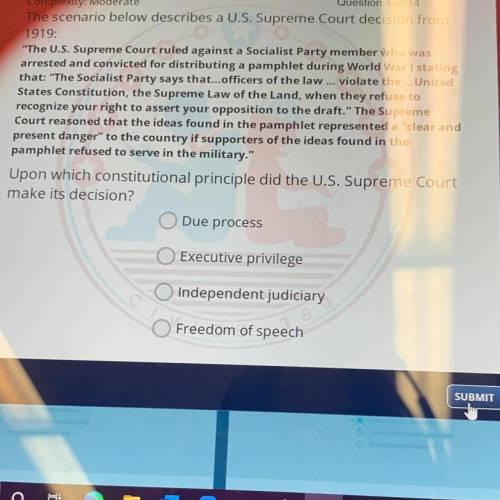Help asap
The scenario below describes a U. S. Supreme Court decision Tror
1919:
“The...

Help asap
The scenario below describes a U. S. Supreme Court decision Tror
1919:
“The U. S. Supreme Court ruled against a Socialist Party member who was
arrested and convicted for distributing a pamphlet during World War I stating
that: "The Socialist Party says that...officers of the law ... violate the... United
States Constitution, the Supreme Law of the Land, when they refuse to
recognize your right to assert your opposition to the draft." The Supreme
Court reasoned that the ideas found in the pamphlet represented a "clear and
present danger" to the country if supporters of the ideas found in the
pamphlet refused to serve in the military."
Upon which constitutional principle did the U. S. Supreme Court
make its decision?
Due process
Executive privilege
Independent judiciary
Freedom of speech


Answers: 3


Other questions on the subject: History

History, 21.06.2019 17:00, allison9746
Which statement best describes the relationship between the fifth and fourteenth amendments?
Answers: 3

History, 21.06.2019 23:30, laurieburgess804
What was the great awakening? a. a religious movement b. a social movement against slavery c. a political rebellion d. a scientific movement
Answers: 2

History, 22.06.2019 00:00, FantasticFerret
To keep other european powers from threatening its empire in america, spain sent soldiers, settlers, and?
Answers: 3

History, 22.06.2019 04:50, genyjoannerubiera
What are the expressed and implied powers of the president
Answers: 1
You know the right answer?
Questions in other subjects:


German, 18.12.2020 18:40



English, 18.12.2020 18:40


Mathematics, 18.12.2020 18:40

Mathematics, 18.12.2020 18:40


Biology, 18.12.2020 18:40



